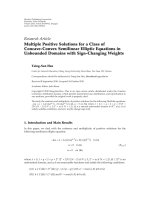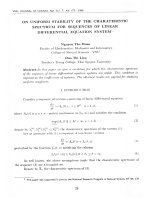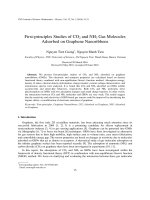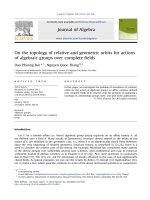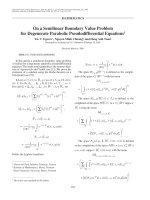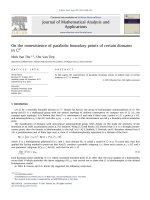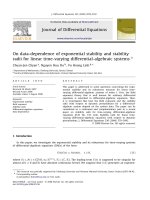DSpace at VNU: On a class of degenerate and singular elliptic systems in bounded domains
Bạn đang xem bản rút gọn của tài liệu. Xem và tải ngay bản đầy đủ của tài liệu tại đây (202.47 KB, 10 trang )
J. Math. Anal. Appl. 360 (2009) 422–431
Contents lists available at ScienceDirect
Journal of Mathematical Analysis and
Applications
www.elsevier.com/locate/jmaa
On a class of degenerate and singular elliptic systems
in bounded domains
Nguyen Thanh Chung a,∗ , Hoang Quoc Toan b
a
b
Department of Mathematics and Informatics, Quang Binh University, 312 Ly Thuong Kiet, Dong Hoi, Quang Binh, Viet Nam
Department of Mathematics, Hanoi University of Science, 334 Nguyen Trai, Hanoi, Viet Nam
a r t i c l e
i n f o
a b s t r a c t
Article history:
Received 4 March 2009
Available online 2 July 2009
Submitted by V. Radulescu
This paper deals with the nonexistence and multiplicity of nonnegative, nontrivial solutions
to a class of degenerate and singular elliptic systems of the form
− div(h1 (x)∇ u ) = λ F u (x, u , v ) in Ω,
− div(h2 (x)∇ v ) = λ F v (x, u , v ) in Ω,
Keywords:
Degenerate
Singular
Semilinear elliptic systems
Minimum principle
Mountain pass theorem
Nonexistence
Multiplicity
where Ω is a bounded domain with smooth boundary ∂Ω in R N , N
2, and h i : Ω →
[0, ∞), hi ∈ L 1loc (Ω), h i (i = 1, 2) are allowed to have “essential” zeroes at some points in Ω ,
( F u , F v ) = ∇ F , and λ is a positive parameter. Our proofs rely essentially on the critical
point theory tools combined with a variant of the Caffarelli–Kohn–Nirenberg inequality
in [P. Caldiroli, R. Musina, On a variational degenerate elliptic problem, NoDEA Nonlinear
Differential Equations Appl. 7 (2000) 189–199].
© 2009 Elsevier Inc. All rights reserved.
1. Introduction and main results
In this paper, we are concerned with a class of semilinear elliptic systems of the form
− div(h1 (x)∇ u ) = λ F u (x, u , v ) in Ω,
− div(h2 (x)∇ u ) = λ F v (x, u , v ) in Ω,
u=v =0
on ∂Ω,
(1.1)
where Ω is a bounded domain in R N ( N 2), ( F u , F v ) = ∇ F stands for the gradient of F in the variables w = (u , v ) ∈ R2
and λ is a positive parameter. We point out the fact that if h1 (x) = h2 (x) ≡ 1, the problem was intensively studied in the
last decades. We refer to some interesting works [3,8,10,17,23].
In a recent paper [6], P. Caldiroli and R. Musina have considered the Dirichlet elliptic problem of the form
− div h(x)∇ u = f (x, u ) in Ω,
(1.2)
where Ω is a (bounded or unbounded) domain in R N (N 2), and h is a nonnegative measurable weighted function that is
allowed to have “essential” zeroes at some points in Ω , i.e., the function h can have at most a finite number of zeroes in Ω .
More precisely, the authors assumed that there exists an exponent α ∈ (0, 2] such that the function h decreases more slowly
than |x − z|α near every point z ∈ h−1 {0}. Then, they proved some interesting compact results and obtained the existence of
a nontrivial solution for (1.2) in a suitable function space using the Mountain pass theorem [1]. These results were used to
*
Corresponding author.
E-mail addresses: (N.T. Chung), (H.Q. Toan).
0022-247X/$ – see front matter
doi:10.1016/j.jmaa.2009.06.073
©
2009 Elsevier Inc. All rights reserved.
N.T. Chung, H.Q. Toan / J. Math. Anal. Appl. 360 (2009) 422–431
423
study the existence of a solution for a class of degenerate elliptic systems by N.B. Zographopoulos [22] and G. Zhang et al.
[24].
In [22], N.B. Zographopoulos considered the degenerate semilinear elliptic systems of the form
⎧
⎨ − div(h1 (x)∇ u ) = λμ(x)|u |γ −1 | v |δ+1 in Ω,
− div(h2 (x)∇ v ) = λμ(x)|u |γ +1 | v |δ−1 in Ω,
⎩
u=v =0
on ∂Ω,
(1.3)
where the functions h i ∈ L 1loc (Ω) and h i (i = 1, 2) are allowed to have “essential” zeroes at some points in Ω , the function
μ ∈ L ∞ (Ω) and may change sign in Ω , λ is a positive parameter and the nonnegative constants γ , δ satisfy the following
conditions
γ + 1 < p < 2α ,
γ +1 δ+1
+
p
2α =
q
δ + 1 < q < 2β ,
γ +1
= 1,
2N
N −2+α
2α
2β =
,
+
δ+1
2β
2N
N −2+β
,
< 1,
α , β ∈ (0, 2).
Using arguments of Mountain pass type [1], the author showed the existence of a nontrivial solution of (1.3) in the supercritical case, i.e.
γ +1
2
+
δ+1
2
> 1.
(1.4)
In the critical case γ = δ = 0, the author also established the existence of a positive principal eigenvalue λ1 for system (1.3)
and some perturbations of its.
Motivated by the results in [2,6,8,18,22], G. Zhang et al. [24] obtained some existence results for (1.1) under subcritical
growth conditions and the primitive F (x, u , v ) being intimately related to the first eigenvalue of a corresponding linear
system.
In the present paper, we consider system (1.1) with the functions h i (i = 1, 2) as in [22] and [24]. Under the suitable
conditions on the nonlinearities F u (x, u , v ) and F v (x, u , v ), using the Minimum principle (see [20, p. 4, Theorem 1.2]) and
the Mountain pass theorem of A. Ambrosetti and P. Rabinowitz [1], we show that system (1.1) has at least two nonnegative,
nontrivial solutions provided that λ is large enough. We also prove that the system has no nontrivial solution in case when
the parameter λ is small enough. Thus, these results are completely natural extensions from [22] and [24]. Our paper is
motivated by the interesting ideas introduced in [3,10,13,16]. In order to state our main results, we introduce next some
hypotheses on the structure of the problem.
Throughout this paper, we assume the functions h1 and h2 satisfying the following conditions:
(H1 ) The function h1 : Ω → [0, ∞) belongs to L 1loc (Ω) and there exists a constant α
−α
lim inf |x − z|
x→ z
h1 (x) > 0 for all z ∈ Ω.
(H2 ) The function h2 : Ω → [0, ∞) belongs to L 1loc (Ω) and there exists a constant β
−β
lim inf |x − z|
x→ z
0 such that
0 such that
h2 (x) > 0 for all z ∈ Ω.
It should be observed that a model example for (H1 ) (similar to (H2 )) is that h1 (x) = |x|α (see [11,12]). The case α = 0
covers the “isotropic” case corresponding to the Laplacian operator. In [6], the conditions (H1 ) and (H2 ) were excellently
used by P. Caldiroli and R. Musina. The authors proved that if a function h satisfies the conditions as in (H1 ) (similar to (H2 )),
then there exist a finite set Z = { z1 , z2 , . . . , zk } ⊂ Ω and numbers r , δ > 0 such that the balls B i = B r ( zi ) (i = 1, 2, . . . , k) are
mutually disjoint and
h(x)
δ|x − zi |α ∀x ∈ B i , i = 1, 2, . . . , k,
h(x)
δ ∀x ∈ Ω
and
k
Bi.
i =1
This says the conditions (H1 ) and (H2 ) implying that the elliptic operators in system (1.1) are degenerate and singular. Moreover, the sets Z h1 = {x ∈ Ω : h1 (x) = 0} and Z h2 = { z ∈ Ω : h2 ( z) = 0} are finite, the potentials h1 (x) and h2 (x) respectively
behave like |x|α and |x|β around their degenerate points. Such problems come from the consideration of standing waves
in anisotropic Schrödinger systems (see [15]). They arise in many areas of applied physics, including nuclear physics, field
424
N.T. Chung, H.Q. Toan / J. Math. Anal. Appl. 360 (2009) 422–431
theory, solid waves and problems of false vacuum. These problems are introduced as models for several physical phenomena
related to equilibrium of continuous media which somewhere are perfect insulators (see [9, p. 79]). For more information
and connection with problems of this type, the readers may consult in [14,19] and the references therein.
Next, we assume that F (x, t , s) is a C 1 -function on Ω × [0, ∞) × [0, ∞) → R, satisfying the hypotheses below:
(F1 ) There exist two positive constants C 1 and C 2 such that
C 1 t γ sδ+1 ,
F t (x, t , s)
F s (x, t , s)
for all (t , s) ∈ R2 , a.e. x ∈ Ω and some
C 2 t γ +1 s δ
γ , δ > 1 with
γ +1
2N
,
N −2+β
δ + 1 < q < 2β =
p
α , β ∈ (0, 2).
(F2 ) There exist positive constants η , s0 , t 0 such that F (x, t , s)
a.e. x ∈ Ω , where p and q are given as in (F1 ).
(F3 ) It holds that
F (x, t , s)
lim sup
+
δ+1
q
= 1, γ2+1 +
α
δ+1
2β
< 1, and γ + 1 < p < 2α =
0 for all (t , s) ∈ R2 with t p + sq
2N
,
N −2+α
η and F (x, t 0 , s0 ) > 0 for
0
γ +1 sδ+1
|(t ,s)|→∞, t ,s>0 t
uniformly in x ∈ Ω .
It is clear that by the presence of the functions h1 , h2 , weak solutions of system (1.1) must be found in a suitable space.
To this purpose, we define the Hilbert spaces H 01 (Ω, h1 ) and H 01 (Ω, h2 ) as the closures of C 0∞ (Ω) with respect to the norms
u
h1
h1 (x)|∇ u |2 dx
=
1
2
Ω
for all u ∈ C 0∞ (Ω) and
v
h2
h2 (x)|∇ v |2 dx
=
1
2
Ω
for all v ∈
norm
w
C 0∞ (Ω), respectively, and set H
H
= u
h1
+ v
= H 01 (Ω, h1 ) × H 01 (Ω, h2 ). Then, it is clear that H is a Hilbert space under the
h2
for all w = (u , v ) ∈ H , and with respect to the scalar product
ϕ, ψ
H
=
h1 (x)∇ ϕ1 ∇ψ1 + h2 (x)∇ ϕ2 ∇ψ2 dx
Ω
for all ϕ = (ϕ1 , ϕ2 ), ψ = (ψ1 , ψ2 ) ∈ H .
The key in our arguments is the following lemma, which is introduced by P. Caldiroli and R. Musina [6] as the generalization of the Caffarelli–Kohn–Nirenberg inequality in [4] and [7].
Lemma 1.1. (See [6, Proposition 2.5].) Let Ω be a bounded domain in R N , N
to L 1loc (Ω) and satisfies the condition
2. Assume that the function h : Ω → [0, +∞) belongs
lim inf |x − z|−φ h(x) > 0
(1.5)
x→ z
for all z ∈ Ω , where φ ∈ (0, 2). Then there exists a constant C φ > 0 depending on φ such that
|ϕ |2φ dx
2
2
φ
Ω
for every ϕ
h(x)|∇ ϕ |2 dx
Cφ
Ω
∈ C 0∞ (Ω), where 2φ
=
2N
.
N −2+φ
By Lemma 1.1, Propositions 3.2 and 3.4 in [6] we have the following remark, which helps us to overcome the lack of
compactness.
Remark 1.2. Assume that the hypotheses (H1 ) and (H2 ) are satisfied, then we conclude that
N.T. Chung, H.Q. Toan / J. Math. Anal. Appl. 360 (2009) 422–431
425
2
(i) the embedding H → L 2α (Ω) × L β (Ω) is continuous;
(ii) the embedding H → L i (Ω) × L j (Ω) is compact for all i ∈ [1, 2α ) and all j ∈ [1, 2β ).
Definition 1.3. We say that w = (u , v ) ∈ H is a weak solution of system (1.1) if and only if
h1 (x)∇ u ∇ ϕ1 + h2 (x)∇ v ∇ ϕ2 dx − λ
Ω
for all
f (x, u , v )ϕ1 + g (x, u , v )ϕ2 dx = 0
Ω
ϕ = (ϕ1 , ϕ2
) ∈ C ∞ (Ω, R2 ).
0
Now, we can describe our main results as follows.
Theorem 1.4. Assume that the conditions (H1 )–(H2 ) and (F1 ) are satisfied. Then, there exists a constant λ > 0 such that for all λ < λ,
system (1.1) has no nontrivial weak solution.
Theorem 1.5. Assume that the conditions (H1 )–(H2 ) and (F1 )–(F3 ) are satisfied. Then, there exists a constant λ > 0 such that system (1.1) has at least two distinct, nonnegative, nontrivial weak solutions, provided that λ λ.
2. Proof of the main results
In this section, we denote by λ1 (h) the first eigenvalue of the following Dirichlet problem
− div(h(x)∇ u ) = λu in Ω,
u=0
on ∂Ω,
(2.1)
where the function h satisfies all assumptions of Lemma 1.1. Then, we recall the result in [6] that λ1 (h) > 0 and is given by
λ1 (h) :=
2
Ω h (x)|∇φ| dx
inf
φ∈ H 01 (Ω,h)\{0}
Ω
|φ|2 dx
(2.2)
.
Moreover, it is achieved in H 01 (Ω, h) by a nonnegative and unique (up to multiplicative constant) function φ1 .
We also let λ1 be the first eigenvalue of the following Dirichlet problem (see [22] or [24, Lemma 2.3] for μ(x) ≡ 1),
⎧
⎨ − div(h1 (x)∇ u ) = λ|u |γ −1 | v |δ+1 in Ω,
γ +1 | v |δ−1 in Ω,
⎩ − div(h2 (x)∇ v ) = λ|u |
u=v =0
on ∂Ω,
where the functions h1 (x) and h2 (x) as in (H1 ) and (H2 ),
tion (F2 ).
Then, we have λ1 > 0 and is given by
λ1 =
γ and δ are two positive real numbers satisfying the condi-
γ +1
δ+1
2
2
Ω ( p h 1 (x)|∇ u | + q h 2 (x)|∇ v | ) dx
γ +1 | v |δ+1 dx
w =(u , v )∈ H \{(0,0)}
Ω |u |
inf
(2.3)
and the associated eigenfunction w 0 = (u 0 , v 0 ) is componentwise nonnegative and is unique (up to multiplication by a
nonzero scalar). Now, we are in the position to prove our main results.
Proof of Theorem 1.4. If w = (u , v ) ∈ H is a weak solution of system (1.1) then multiplying first two equations in (1.1) by u
and v, respectively, integrating by parts and using (F1 ), we get
h1 (x)|∇ u |2 dx = λ
Ω
F u (x, u , v )u dx
Ω
|u |γ +1 | v |δ+1 dx,
λC 1
Ω
and
h2 (x)|∇ u |2 dx = λ
Ω
F v (x, u , v )u dx
Ω
|u |γ +1 | v |δ+1 dx.
λC 2
Ω
426
N.T. Chung, H.Q. Toan / J. Math. Anal. Appl. 360 (2009) 422–431
It follows that
γ +1
p
h1 (x)|∇ u |2 +
δ+1
q
h2 (x)|∇ v |2 dx
|u |γ +1 | v |δ+1 dx.
λ(C 1 + C 2 )
Ω
Ω
Hence, by choosing λ =
λ1
, where
C 1 +C 2
λ1 is given by (2.3), we conclude the proof of Theorem 1.4. ✷
In order to prove Theorem 1.5 using critical point theory, we first set F (x, t , s) = 0 for all t, s < 0, and consider for each
λ > 0 the functional Φλ : H → R given by
Φλ ( w ) =
1
h1 (x)|∇ u |2 + h2 (x)|∇ v |2 dx − λ
2
Ω
F (x, u , v ) dx
Ω
= Λ( w ) − λ I ( w ),
(2.4)
where
1
Λ( w ) =
h1 (x)|∇ u |2 + h2 (x)|∇ v |2 dx,
2
(2.5)
Ω
I (w) =
F (x, u , v ) dx
(2.6)
Ω
for all w = (u , v ) ∈ H . A simple computation implies that Φλ is well defined and of C 1 class in H . Thus, weak solutions
of (1.1) are exactly the critical points of the functional Φλ . We first have the following lemma.
Lemma 2.1. The functional Φλ given by (2.4) is weakly lower semicontinuous in the space H .
Proof. Let { w m } = {(um , v m )} be a sequence that converges weakly to w = (u , v ) in the space H = H 01 (Ω, h1 ) × H 01 (Ω, h2 ).
By the weak lower semicontinuity of the norms in the spaces H 01 (Ω, h1 ) and H 01 (Ω, h2 ) we deduce that
h1 (x)|∇ um |2 + h2 (x)|∇ v m |2 dx
lim inf
m→∞
Ω
h1 (x)|∇ u |2 + h2 (x)|∇ v |2 dx.
(2.7)
Ω
We shall show that
F (x, um , v m ) dx =
lim
m→∞
Ω
F (x, u , v ) dx.
(2.8)
Ω
Indeed, we have
F (x, um , v m ) − F (x, u , v ) dx =
Ω
∇ F x, w + θm ( w m − w ) · ( w m − w ) dx
Ω
=
F u x, u + θ1,m (um − u ), v + θ2,m ( v m − v ) (um − u ) dx
Ω
+
F v x, u + θ1,m (um − u ), v + θ2,m ( v m − v ) ( v m − v ) dx,
Ω
where θm = (θ1,m , θ2,m ) and 0 θ1,m (x), θ2,m (x) 1 for all x ∈ Ω .
Now, using (F1 ) and Hölder’s inequality we conclude that
F (x, um , v m ) − F (x, u , v ) dx
Ω
F u x, u + θ1,m (um − u ), v + θ2,m ( v m − v ) |um − u | dx
Ω
+
F v x, u + θ1,m (um − u ), v + θ2,m ( v m − v ) | v m − v | dx
Ω
(2.9)
N.T. Chung, H.Q. Toan / J. Math. Anal. Appl. 360 (2009) 422–431
γ
u + θ1,m (um − u )
C1
v + θ2,m ( v m − v )
δ+1
427
|um − u | dx
Ω
+ C2
u + θ1,m (um − u )
γ +1
δ
v + θ2,m ( v m − v ) | v m − v | dx
Ω
C 1 u + θ1,m (um − u )
γ
L p (Ω)
+ C 2 u + θ1,m (um − u )
v + θ2,m ( v m − v )
γ +1
L p (Ω)
v + θ2,m ( v m −
δ+1
um − u L p (Ω)
L q (Ω)
δ
v ) Lq (Ω) v m − v Lq (Ω) .
(2.10)
On the other hand, since 2 < γ + 1 < p < 2α and 2 < γ + 1 < q < 2β , by Remark 1.2, the sequence { w m } converges strongly
to w = (u , v ) in the space L p (Ω) × L q (Ω), i.e., {um } converges strongly to u in L p (Ω) and { v m } converges strongly to v
in L q (Ω). Hence, it is easy to see that the sequences { u + θ1,m (um − u ) L p (Ω) } and { v + θ2,m ( v m − v ) L q (Ω) } are bounded.
Thus, it follows from (2.10) that relation (2.8) holds true.
Finally, relations (2.7) and (2.8) imply that
lim inf Φλ ( w m )
Φλ ( w )
m→∞
(2.11)
and the functional Φλ is weakly lower semicontinuous in the space H .
✷
Lemma 2.2. The functional Φλ given by (2.4) is coercive and bounded from below in the space H .
Proof. By (F1 ), there exists C 3 > 0 such that for all (t , s) ∈ R2 and a.e. x ∈ Ω we deduce that
F (x, t , s)
C |t |γ +1 |s|δ+1 .
(2.12)
3
For real numbers p , q, γ , δ as in (F2 ), we define the number θ by
θ=
1
2 max{
γ +1 δ+1
, q }
p
> 0.
(2.13)
Then, by (F3 ), there is a positive constant M λ depending on λ such that for all (t , s) ∈ R2 with |(t , s)|
x ∈ Ω we get
M λ and for a.e.
θλ1 γ +1 δ+1
|t |
|s| ,
2λ
F (x, t , s)
(2.14)
where λ1 is given by (2.3). Hence, relations (2.12) and (2.14) imply that for all (t , s) ∈ R2 and for a.e. x ∈ Ω , it holds that
θλ1
λ F (x, t , s)
|t |γ +1 |s|δ+1 + C λ
2
(2.15)
for some positive real number C λ which depends on λ. Hence, by the definition of the functional Φλ we deduce that
Φλ ( w )
γ +1
θ
p
h1 (x)|∇ u |2 dx +
δ+1
q
θλ1
h2 (x)|∇ u |2 dx −
Ω
2
|u |γ +1 | v |δ+1 + C λ dx
Ω
θ(γ + 1)
u
2p
2
h1
= C4 u
2
h1
+ v
+
2
h2
θ(δ + 1)
2q
v
2
h2
− C λ |Ω| N
− C λ |Ω| N ,
for all w = (u , v ) ∈ H , where
C4 =
θ
2
min
γ +1 δ+1
p
,
q
and | · |d denotes the d-dimensional Lebesgue measure in R N , so the functional Φλ is coercive and bounded from below.
Lemma 2.3. If w = (u , v ) ∈ H is a weak solution of system (1.1) then u
0 and v
0 in Ω .
Proof. Indeed, if w = (u , v ) ∈ H is a weak solution of system (1.1), then we have
0 = D Φλ ( w ), w −
h1 (x)∇ u · ∇ u − + h2 (x)∇ v · ∇ v − dx − λ
=
Ω
= u
F u (x, u , v )u − + F v (x, u , v ) v − dx
Ω
− 2
h1
+ v
− 2
h2 ,
✷
428
N.T. Chung, H.Q. Toan / J. Math. Anal. Appl. 360 (2009) 422–431
where u − (x) = min{u (x), 0}, v − (x) = min{ v (x), 0} are the negative parts of u and v, respectively. Moreover, by relation (2.2)
and the fact that
0 = u−
2
h1
|u − |2 dx,
λ1 (h1 )
Ω
and
0 = v−
2
h2
| v − |2 dx,
λ1 (h2 )
Ω
it follows that u (x)
0 for a.e. x ∈ Ω .
0 and v (x)
✷
By Lemmas 2.1, 2.2 and 2.3, applying the Minimum principle (see [20, p. 4, Theorem 1.2]), the functional Φλ has a global
minimum and thus system (1.1) admits a nonnegative weak solution w 1 = (u 1 , v 1 ) ∈ H . The following lemma shows that
the solution w 1 is not trivial provided that λ is large enough.
λ, inf H Φλ < 0, and hence the solution w 1 ≡ 0.
Lemma 2.4. There exists a constant λ > 0 such that for all λ
Proof. Indeed, let Ω be a sufficiently large compact subset of Ω , a function w 0 = (u 0 , v 0 ) ∈ H is taken such that u 0 (x) = t 0 ,
v 0 (x) = s0 on Ω , 0 u 0 (x) t 0 , 0 v 0 (x) s0 on Ω\Ω , where t 0 , s0 are given as in (F2 ). Then we have
γ +1 δ+1
F (x, t 0 , s0 ) dx − C 3 t 0
F (x, u 0 , v 0 ) dx
Ω
|Ω\Ω | N > 0.
s0
(2.16)
Ω
So, we deduce that
Φλ ( w 0 ) =
1
h1 (x)|∇ u 0 |2 dx + h2 (x)|∇ v 0 |2 dx − λ
2
Ω
1
2
u0
F (x, u 0 , v 0 ) dx
Ω
2
H1
+
1
2
2
H2
v0
γ +1 δ+1
−λ
F (x, t 0 , s0 ) dx − C 3 t 0
|Ω\Ω | N .
s0
Ω
Hence, if Ω is large enough, there exists λ such that for all λ
for all λ λ. ✷
λ we have Φλ ( w 0 ) < 0, thus w 1 ≡ 0. Moreover, Φλ ( w 1 ) < 0
In the next parts, we shall show the existence of the second weak solution w 2 = (u 2 , v 2 ) ∈ H ( w 2 = w 1 ) of system (1.1)
by applying the Mountain pass theorem in [1]. To this purpose, we first show that for all λ λ, the functional Φλ has the
geometry of the Mountain pass theorem.
Lemma 2.5. There exist a constant ρ ∈ (0, w 1
H)
and a constant r > 0 such that Φλ ( w )
r for all w ∈ H with w
H
= ρ.
Proof. For each w = (u , v ) ∈ H we set
p
Ω w = x ∈ Ω : u (x)
q
+ v (x) > η ,
(2.17)
where p , q and η are given as in (F2 ). Then, we have F (x, u (x), v (x))
inequalities, relations (2.2) and (2.12) we get
F (x, u , v ) dx
Ωw
0 on Ω\Ω w . Hence, using Young’s and Hölder’s
|u |γ +1 | v |δ+1 dx
C3
Ωw
γ +1
C3
p
|u | p +
δ+1
q
| v |q dx
Ωw
C3
γ +1
p
|u | dx
p
p
p
|Ω w |
1−
p
p
+ C3
Ωw
C5
γ +1
p
u
1−
p
|Ω w |
h1
δ+1
q
| v | dx
q
q
q
|Ω w |
1−
q
q
Ωw
p
p
+ C5
δ+1
q
q
v
1−
q
|Ω w | q
h2
,
(2.18)
N.T. Chung, H.Q. Toan / J. Math. Anal. Appl. 360 (2009) 422–431
429
where p ∈ ( p , 2α ) and q ∈ (q, 2β ). Thus,
Φλ ( u , v )
1
2
2
h1
u
+
1
2
v
2
h2
−λ
F (x, u , v ) dx
Ωw
u
2
h1
1
− λC 5
2
γ +1
p
u
p
1−
p −2
|Ω w | p
h1
+ v
1
2
h2
2
− λC 5
δ+1
q
q
v
1−
q −2
|Ω w | q
h2
(2.19)
.
Since p > γ + 1 > 2 and q > δ + 1 > 2, in order to prove Lemma 2.5, it is enough to show that
|Ω w | → 0 as
w
= u
H
h1
+ v
h2
→ 0.
> 0 be arbitrary, we choose Ω ⊂ Ω a compact subset, large enough such that |Ω\Ω | <
Ω w , := Ω w ∩ Ω . Then, by Remark 1.2, it is clear that for all w = (u , v ) ∈ H we deduce that
Indeed, let
u
p
h1
+ v
q
h2
p
q
|u | p dx + C q
Cp
Ω
and denote by
| v |q dx
Ω
min
p
q
C p , Cq
min
p
q
C p , Cq
|u | p + | v |q dx
Ωw,
η|Ω w , |,
(2.20)
where C p and C q denote by the best constants in the embeddings
→ L (Ω) and
→ L (Ω), respectively, and η as in (F2 ).
Letting w H → 0 we deduce that u h1 → 0 and v h2 → 0. Combining these with the above information we conclude
that |Ω w , | → 0. Since Ω w ⊂ Ω w , ∪ Ω\Ω we have
H 01 (Ω, h1 )
|Ω w |
with
H 01 (Ω, h2 )
p
q
|Ω w , | +
> 0 is arbitrary. Thus, |Ω w | → 0 as w
H
→ 0. The proof of the lemma is complete. ✷
Lemma 2.6. The functional Φλ given by (2.4) satisfies the Palais–Smale condition in H .
Proof. By Lemma 2.2, we deduce that Φλ is coercive on H . Let { w m } = {(um , v m )} be a Palais–Smale sequence for the
functional Φλ in H , i.e.
Φλ ( u m )
C6
D Φλ (um ) → 0 in H −1 as m → ∞,
for all m,
(2.21)
where H −1 is the dual space of H .
Since Φλ is coercive on H , relation (2.21) implies that the sequence { w m } is bounded in H . Since H is a Hilbert space,
there exists w = (u , v ) ∈ H such that, passing to a subsequence, still denoted by { w m }, it converges weakly to w in H .
Hence, { w m − w } is bounded. This and (2.21) imply that D Φλ ( w m )( w m − w ) converges to 0 as m → ∞. Using the
condition (F1 ) combined with Hölder’s inequality we conclude that
F u (x, um , v m ) |um − u | dx
|um |γ | v m |δ+1 |u − um | dx
C1
Ω
Ω
C 1 um
γ
L p (Ω)
1
v m δ+
L q (Ω) u m − u
L p (Ω) ,
(2.22)
L q (Ω) .
(2.23)
and
F v (x, um , v m ) | v m − v | dx
|um |γ +1 | v m |δ |u − um | dx
C2
Ω
Ω
C 2 um
γ +1
L p (Ω)
v m δLq (Ω) v m − v
It follows from relations (2.22) and (2.23) that
D I ( w m )( w m − w ) =
F u (x, um , v m )(um − u ) + F v (x, um , v m )( v m − v ) dx
Ω
C 1 um
γ
L p (Ω)
1
v m δ+
L q (Ω) u m − u
L p (Ω)
+ C 2 um
γ +1
L p (Ω)
v m δLq (Ω) v m − v
L q (Ω)
430
N.T. Chung, H.Q. Toan / J. Math. Anal. Appl. 360 (2009) 422–431
where the functional I is given by (2.6). Therefore, we deduce by Remark 1.2 that
lim D I ( w m )( w m − w ) = 0.
(2.24)
m→∞
Combining this with (2.21) and the fact that
D Λ( w m )( w m − w ) = D Φλ ( w m )( w m − w ) + D I ( w m )( w m − w )
imply that
lim D Λ( w m )( w m − w ) = 0,
(2.25)
m→∞
where the functional Λ is given by (2.5).
Hence, by the convexity of the functional Λ, we have
Λ( w ) − lim sup Λ( w m ) = lim inf Λ( w ) − Λ( w m )
m→∞
m→∞
lim D Λ( w m )( w − w m ) = 0
(2.26)
m→∞
and the weak lower semicontinuity of Λ implies that
lim Λ( w m ) = Λ( w ).
(2.27)
m→∞
We now assume by contradiction that { w m } does not converge strongly to w in H , then there exist a constant
. We have
subsequence of { w m }, still denoted by { w m }, such that w m − w
1
2
1
wm + w
2
2
Λ( w ) + Λ( w m ) − Λ
=
1
4
wm − u
2
1
4
2
.
> 0 and a
(2.28)
Letting m → ∞, relation (2.28) gives
lim sup Λ
wm + w
m→∞
Λ( w ) −
2
1
4
2
.
(2.29)
We remark that the sequence { w m2+ w } also converges weakly to w in H . So, we get
Λ( w )
lim inf Λ
m→∞
wm + w
2
,
(2.30)
which contradicts (2.29). Therefore, { w m } converges strongly to w in H and the functional Φλ satisfies the Palais–Smale
condition in H . ✷
Proof of Theorem 1.5. By Lemmas 2.1–2.4, system (1.1) admits a nonnegative, nontrivial weak solution w 1 = (u 1 , v 1 ) as the
global minimizer of Φλ . Set
c := inf
max
χ ∈Γ w ∈χ ([0,1])
Φλ ( w ),
(2.31)
where Γ := {χ ∈ C ([0, 1], H ): χ (0) = 0, χ (1) = w 1 }.
Lemmas 2.5–2.6 show that all assumptions of the Mountain pass theorem in [1] are satisfied, Φλ ( w 1 ) = Φλ ( w 1 ) < 0 and
w 1 H > ρ . Then, c is a critical value of Φλ , i.e. there exists w 2 = (u 2 , v 2 ) ∈ H such that D Φλ ( w 2 )(ϕ ) = 0 for all ϕ ∈ H or
w 2 is a weak solution of (1.1). Moreover, w 2 is not trivial and w 2 ≡ w 1 since Φλ ( w 2 ) = c > 0 > Φλ ( w 1 ). Theorem 1.5 is
completely proved. ✷
3. Final comments
In this section, we make some comments regarding extensions of system (1.1). While uniform elliptic problems (equations
and systems) are intensively studied in the last decades, the degenerate elliptic problems still contain some unknown things.
For problem (1.1), the reader may be interested in some further directions of research as follows:
1. In the hypothesis (F1 ), we require that γ , δ > 1. This condition helps us to show that the functional has the geometry
of the Mountain pass theorem [1] (see Lemma 2.5). What happens if we only require that γ , β > 0? In this paper, we
have not considered the problem with critical exponent, i.e., γ = 2α − 1 and δ = 2β − 1 yet (see [21]).
2. May Theorem 1.4 and Theorem 1.5 be valid for the discontinuous nonlinearities as in [24]?
3. Finally, the reader may study the existence of sign-changing solutions for system (1.1) (see [5, Theorems 2.12 and 2.13]).
N.T. Chung, H.Q. Toan / J. Math. Anal. Appl. 360 (2009) 422–431
431
Acknowledgments
The authors would like to thank the referees for their suggestions and helpful comments which improved the presentation of the paper. This work was
supported by National Foundation for Science and Technology Development (NAFOSTED).
References
[1] A. Ambrosetti, P.H. Rabinowitz, Dual variational methods in critical points theory and applications, J. Funct. Anal. 4 (1973) 349–381.
[2] L. Boccardo, D.G. De Figueiredo, Some remarks on a system of quasilinear elliptic equations, NoDEA Nonlinear Differential Equations Appl. 9 (2002)
309–323.
[3] J.F. Bonder, Multiple positive solutions for quasilinear elliptic problems with sign-changing nonlinearities, Abstr. Appl. Anal. 2004 (12) (2004) 1047–
1056.
[4] L. Caffarelli, R. Kohn, L. Nirenberg, First order interpolation inequalities with weights, Compos. Math. 53 (1984) 259–275.
[5] P. Caldiroli, R. Musina, On the existence of extremal functions for a weighted Sobolev embedding with critical exponent, Calc. Var. Partial Differential
Equations 8 (4) (1999) 365–387.
[6] P. Caldiroli, R. Musina, On a variational degenerate elliptic problem, NoDEA Nonlinear Differential Equations Appl. 7 (2000) 189–199.
[7] F. Catrina, Z.Q. Wang, On the Kaffarelli–Kohn–Nirenberg inequalities: Sharp constants, existence (and non existence) and symmetry of extremal functions, Comm. Pure Appl. Math. 54 (2001) 229–258.
[8] D.G. Costa, On a class of elliptic systems in R N , Electron. J. Differential Equations 07 (1994) 1–14.
[9] R. Dautray, J.L. Lions, Mathematical Analysis and Numerical Methods for Science and Technology I: Physical Origins and Classical Methods, SpringerVerlag, Berlin, 1985.
[10] C. Maya, R. Shivaji, Multiple positive solutions for a class of semilinear elliptic boundary value problems, Nonlinear Anal. 38 (4) (1999) 497–504.
[11] M. Mih˘ailescu, Nonlinear eigenvalue problems for some degenerate elliptic operators on R N , Bull. Belg. Math. Soc. 12 (2005) 435–448.
[12] M. Mih˘ailescu, V. R˘adulescu, Ground state solutions of nonlinear singular Schrödinger equations with lack compactness, Math. Methods Appl. Sci. 26
(2003) 897–906.
[13] M. Mih˘ailescu, V. R˘adulescu, A multiplicity result for a nonlinear degenerate problem arising in the theory of electrorheological fluids, Proc. R. Soc.
Lond. Ser. A 462 (2006) 2625–2641.
[14] M.K.V. Murthy, G. Stampachia, Boundary value problems for some degenerate elliptic operators, Ann. Mat. Pura Appl. 80 (1968) 1–122.
[15] Y.-G. Oh, Existence of semiclassical bound states of nonlinear Schrödinger equations with potentials of the class ( V a ), Comm. Partial Differential
Equations 13 (12) (1988) 1499–1519.
[16] K. Perera, Multiple positive solutions for a class of quasilinear elliptic boundary-value problems, Electron. J. Differential Equations 2003 (7) (2003) 1–5.
[17] P.H. Rabinowitz, On a class of nonlinear Schrödinger equations, Z. Angew. Math. Phys. 43 (1992) 270–291.
[18] N.M. Stavrakakis, N.B. Zographopoulos, Existence results for quasilinear elliptic systems in R N , Electron. J. Differential Equations 39 (1999) 1–15.
[19] E.W. Stredulinsky, Weighted Inequalities and Degenerate Elliptic Partial Differential Equations, Springer-Verlag, Berlin, New York, 1984.
[20] M. Struwe, Variational Methods, second edition, Springer-Verlag, 2008.
[21] V. Radulescu, D. Smets, Critical singular problems on infinite cones, Nonlinear Anal. 54 (6) (2003) 1153–1164.
[22] N.B. Zographopoulos, On a class of degenerate potential elliptic system, NoDEA Nonlinear Differential Equations Appl. 11 (2004) 191–199.
[23] G. Zhang, Y. Wang, On a class of Schrödinger systems with discontinuous nonlinearities, J. Math. Anal. Appl. 331 (2007) 1415–1424.
[24] G. Zhang, Y. Wang, Some existence results for a class of degenerate semilinear elliptic systems, J. Math. Anal. Appl. 333 (2007) 904–918.
